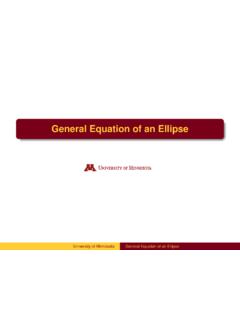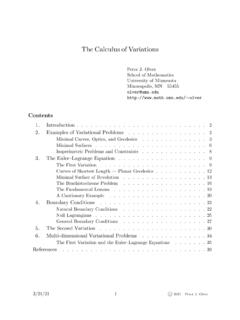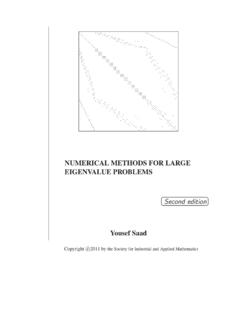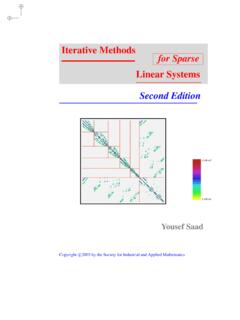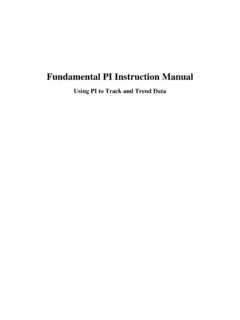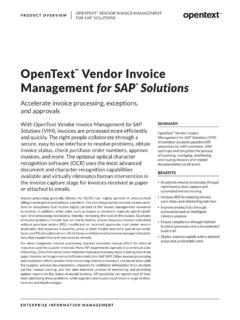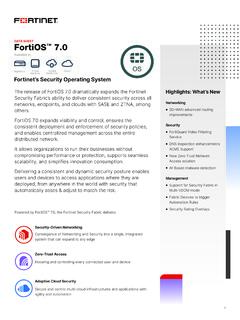Transcription of Introduction to Data Mining - University of Minnesota
1 Introduction to data MiningInstructor s Solution ManualPang-Ning TanMichael SteinbachVipin KumarCopyrightc 2006 Pearson Addison-Wesley. All rights Introduction12 Data53 Exploring Data194 Classification: Basic Concepts, Decision Trees, and ModelEvaluation255 Classification: Alternative Techniques456 Association Analysis: Basic Concepts and Algorithms717 Association Analysis: Advanced Concepts958 Cluster Analysis: Basic Concepts and Algorithms1259 Cluster Analysis: Additional Issues and Algorithms14710 Anomaly Detection157iii1 Introduction1. Discuss whether or not each of the following activities is a data miningtask.(a) Dividing the customers of a company according to their This is a simple database query.(b) Dividing the customers of a company according to their This is an accounting calculation, followed by the applica-tion of a threshold. However, predicting the profitability of a newcustomer would be data Mining .
2 (c) Computing the total sales of a Again, this is simple accounting.(d) Sorting a student database based on student identification Again, this is a simple database query.(e) Predicting the outcomes of tossing a (fair) pair of Since the die is fair, this is a probability calculation. If thedie were not fair, and we needed to estimate the probabilities ofeach outcome from the data , then this is more like the problemsconsidered by data Mining . However, in this specific case, solu-tions to this problem were developed by mathematicians a longtime ago, and thus, we wouldn t consider it to be data Mining .(f) Predicting the future stock price of a company using We would attempt to create a model that can predict thecontinuous value of the stock price. This is an example of the2 Chapter 1 Introductionarea of data Mining known as predictive modelling. We could useregression for this modelling, although researchers in many fieldshave developed a wide variety of techniques for predicting timeseries.
3 (g) Monitoring the heart rate of a patient for We would build a model of the normal behavior of heartrate and raise an alarm when an unusual heart behavior would involve the area of data Mining known as anomaly de-tection. This could also be considered as a classification problemif we had examples of both normal and abnormal heart behavior.(h) Monitoring seismic waves for earthquake In this case, we would build a model of different types ofseismic wave behavior associated with earthquake activities andraise an alarm when one of these different types of seismic activitywas observed. This is an example of the area of data miningknown as classification.(i) Extracting the frequencies of a sound This is signal Suppose that you are employed as a data Mining consultant for an In-ternet search engine company. Describe how data Mining can help thecompany by giving specific examples of how techniques, such as clus-tering, classification, association rule Mining , and anomaly detectioncan be following are examples of possible answers.
4 Clustering can group results with a similar theme and presentthem to the user in a more concise form, , by reporting the10 most frequent words in the cluster. Classification can assign results to pre-defined categories such as Sports, Politics, etc. Sequential association analysis can detect that that certain queriesfollow certain other queries with a high probability, allowing formore efficient caching. Anomaly detection techniques can discover unusual patterns ofuser traffic, , that one subject has suddenly become muchmore popular. Advertising strategies could be adjusted to takeadvantage of such For each of the following data sets, explain whether or not data privacyis an important issue.(a) Census data collected from 1900 1950. No(b) IP addresses and visit times of Web users who visit your (c) Images from Earth-orbiting satellites. No(d) Names and addresses of people from the telephone book. No(e) Names and email addresses collected from the Web.
5 No2 Data1. In the initial example of Chapter 2, the statistician says, Yes, fields 2 and3 are basically the same. Can you tell from the three lines of sample datathat are shown why she says that?Field 2 Field 3 7 for the values displayed. While it can be dangerous to draw con-clusions from such a small sample, the two fields seem to contain essentiallythe same Classify the following attributes as binary, discrete, or continuous. Alsoclassify them as qualitative (nominal or ordinal) or quantitative (interval orratio). Some cases may have more than one interpretation, so briefly indicateyour reasoning if you think there may be some :Age in :Discrete, quantitative, ratio(a) Time in terms of AM or PM. Binary, qualitative, ordinal(b) Brightness as measured by a light meter. Continuous, quantitative,ratio(c) Brightness as measured by people s judgments. Discrete, qualitative,ordinal(d) Angles as measured in degrees between 0 and 360.
6 Continuous, quan-titative, ratio(e) Bronze, Silver, and Gold medals as awarded at the Olympics. Discrete,qualitative, ordinal(f) Height above sea level. Continuous, quantitative, interval/ratio (de-pends on whether sea level is regarded as an arbitrary origin)(g) Number of patients in a hospital. Discrete, quantitative, ratio(h) ISBN numbers for books. (Look up the format on the Web.) Discrete,qualitative, nominal (ISBN numbers do have order information, though)6 Chapter 2 data (i) Ability to pass light in terms of the following values: opaque, translu-cent, transparent. Discrete, qualitative, ordinal(j) Military rank. Discrete, qualitative, ordinal(k) Distance from the center of campus. Continuous, quantitative, inter-val/ratio (depends)(l) Density of a substance in grams per cubic centimeter. Discrete, quan-titative, ratio(m) Coat check number. (When you attend an event, you can often giveyour coat to someone who, in turn, gives you a number that you canuse to claim your coat when you leave.)
7 Discrete, qualitative, nominal3. You are approached by the marketing director of a local company, who be-lieves that he has devised a foolproof way to measure customer explains his scheme as follows: It s so simple that I can t believe thatno one has thought of it before. I just keep track of the number of customercomplaints for each product. I read in a data Mining book that counts areratio attributes, and so, my measure of product satisfaction must be a ratioattribute. But when I rated the products based on my new customer satisfac-tion measure and showed them to my boss, he told me that I had overlookedthe obvious, and that my measure was worthless. I think that he was justmad because our best-selling product had the worst satisfaction since it hadthe most complaints. Could you help me set him straight? (a) Who is right, the marketing director or his boss? If you answered, hisboss, what would you do to fix the measure of satisfaction?
8 The boss is right. A better measure is given bySatisfaction(product) =number of complaints for the producttotal number of sales for the product.(b) What can you say about the attribute type of the original productsatisfaction attribute?Nothing can be said about the attribute type of the original example, two products that have the same level of customer satis-faction may have different numbers of complaints and A few months later, you are again approached by the same marketing directoras in Exercise 3. This time, he has devised a better approach to measure theextent to which a customer prefers one product over other, similar explains, When we develop new products, we typically create severalvariations and evaluate which one customers prefer. Our standard procedureis to give our test subjects all of the product variations at one time and then7ask them to rank the product variations in order of preference. However, ourtest subjects are very indecisive, especially when there are more than twoproducts.
9 As a result, testing takes forever. I suggested that we performthe comparisons in pairs and then use these comparisons to get the , if we have three product variations, we have the customers comparevariations 1 and 2, then 2 and 3, and finally 3 and 1. Our testing time withmy new procedure is a third of what it was for the old procedure, but theemployees conducting the tests complain that they cannot come up with aconsistent ranking from the results. And my boss wants the latest productevaluations, yesterday. I should also mention that he was the person whocame up with the old product evaluation approach. Can you help me? (a) Is the marketing director in trouble? Will his approach work for gener-ating an ordinal ranking of the product variations in terms of customerpreference? , the marketing director is in trouble. A customer may give incon-sistent rankings. For example, a customer may prefer 1 to 2, 2 to 3,but 3 to 1.(b) Is there a way to fix the marketing director s approach?
10 More generally,what can you say about trying to create an ordinal measurement scalebased on pairwise comparisons?One solution: For three items, do only the first two comparisons. Amore general solution: Put the choice to the customer as one of order-ing the product, but still only allow pairwise comparisons. In general,creating an ordinal measurement scale based on pairwise comparison isdifficult because of possible inconsistencies.(c) For the original product evaluation scheme, the overall rankings of eachproduct variation are found by computing its average over all test sub-jects. Comment on whether you think that this is a reasonable ap-proach. What other approaches might you take?First, there is the issue that the scale is likely not an interval or ratioscale. Nonetheless, for practical purposes, an average may be goodenough. A more important concern is that a few extreme ratings mightresult in an overall rating that is misleading.

